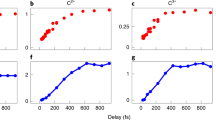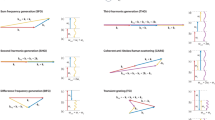Abstract
Modern ultrashort X-ray/XUV (extreme ultraviolet) sources provide unique opportunities to investigate the primary reactions of matter upon energetic excitation. Understanding these processes in molecules on ultrafast timescales is required to improve bespoke high-energy radiation detectors, nanomedicine schemes or to study the molecular composition of interstellar media. However, current experiments struggle to provide a general framework because of the uniqueness and complexity of each system. Here we show the universal role of correlation bands—features created by electron correlation. This is done by studying ultrafast energy relaxation of size-scalable two-dimensional molecules following ionization by an ultrashort XUV pulse. We observed long lifetimes that nonlinearly increase with the number of valence electrons. A general law based on solid-like electron–phonon scattering is proposed, which explains both our results and previously reported measurements. This offers new opportunities in attosecond science and high-energy photophysics.
This is a preview of subscription content, access via your institution
Access options
Access Nature and 54 other Nature Portfolio journals
Get Nature+, our best-value online-access subscription
$29.99 / 30 days
cancel any time
Subscribe to this journal
Receive 12 print issues and online access
$209.00 per year
only $17.42 per issue
Buy this article
- Purchase on Springer Link
- Instant access to full article PDF
Prices may be subject to local taxes which are calculated during checkout



Similar content being viewed by others
Data availability
Data that support the plots within this paper and other findings of this study are available from the corresponding author upon reasonable request. Source data are provided with this paper.
Code availability
The codes that support the findings of this study are available from the corresponding authors upon reasonable request.
References
Maddalena, F. et al. Inorganic, organic and perovskite halides with nanotechnology for high-light yield X- and γ-ray scintillators. Crystals 9, 88 (2019).
Chatterjee, D. K., Fong, L. S. & Zhang, Y. Nanoparticles in photodynamic therapy: an emerging paradigm. Adv. Drug Deliv. Rev. 60, 1627–1637 (2008).
Tielens, A. G. G. M. Interstellar polycyclic aromatic hydrocarbon molecules. Annu. Rev. Astron. Astrophys. 46, 289–337 (2008).
Attar, A. R. et al. Femtosecond X-ray spectroscopy of an electrocyclic ring-opening reaction. Science 356, 54–59 (2017).
Berrah, N. et al. Femtosecond-resolved observation of the fragmentation of buckminsterfullerene following X-ray multiphoton ionization. Nat. Phys. 15, 1279–1283 (2019).
Pertot, Y. et al. Time-resolved X-ray absorption spectroscopy with a water window high-harmonic source. Science 355, 264–267 (2017).
Nisoli, M., Decleva, P., Calegari, F., Palacios, A. & Martín, F. Attosecond electron dynamics in molecules. Chem. Rev. 117, 10760–10825 (2017).
Kobayashi, Y., Chang, K. F., Zeng, T., Neumark, D. M. & Leone, S. R. Direct mapping of curve-crossing dynamics in IBr by attosecond transient absorption spectroscopy. Science 365, 79–83 (2019).
Sansone, G. et al. Electron localization following attosecond molecular photoionization. Nature 465, 763–766 (2010).
Neidel, C. H. et al. Probing time-dependent molecular dipoles on the attosecond time scale. Phys. Rev. Lett. 111, 033001 (2013).
Drescher, L. et al. State-resolved probing of attosecond timescale molecular dipoles. J. Phys. Chem. Lett. 10, 265–269 (2019).
Calegari, F. et al. Ultrafast electron dynamics in phenylalanine initiated by attosecond pulses. Science 346, 336–339 (2014).
Cederbaum, L. S. & Zobeley, J. Ultrafast charge migration by electron correlation. Chem. Phys. Lett. 307, 205–210 (1999).
Kuleff, A. I. & Cederbaum, L. S. Ultrafast correlation-driven electron dynamics. J. Phys. B 47, 124002 (2014).
Lara-Astiaso, M. et al. Attosecond pump–probe spectroscopy of charge dynamics in tryptophan. J. Phys. Chem. Lett. 9, 4570–4577 (2018).
Lépine, F., Ivanov, M. Y. & Vrakking, M. J. J. Attosecond molecular dynamics: fact or fiction? Nat. Photon. 8, 195–204 (2014).
Vacher, M., Bearpark, M. J., Robb, M. A. & Malhado, J. P. Electron dynamics upon ionization of polyatomic molecules: coupling to quantum nuclear motion and decoherence. Phys. Rev. Lett. 118, 083001 (2017).
Despré, V., Golubev, N. V. & Kuleff, A. I. Charge migration in propiolic acid: a full quantum dynamical study. Phys. Rev. Lett. 121, 203002 (2018).
Belshaw, L. et al. Observation of ultrafast charge migration in an amino acid. J. Phys. Chem. Lett. 3, 3751–3754 (2012).
Månsson, E. P. et al. Ultrafast dynamics in the DNA building blocks thymidine and thymine initiated by ionizing radiation. Phys. Chem. Chem. Phys. 19, 19815–19821 (2017).
Galbraith, M. C. E. et al. XUV-induced reactions in benzene on sub-10-fs timescale: nonadiabatic relaxation and proton migration. Phys. Chem. Chem. Phys. 19, 19822–19828 (2017).
Curchod, B. F. E. & Martínez, T. J. Ab initio nonadiabatic quantum molecular dynamics. Chem. Rev. 118, 3305–3336 (2018).
Arnold, C., Vendrell, O., Welsch, R. & Santra, R. Control of nuclear dynamics through conical intersections and electronic coherences. Phys. Rev. Lett. 120, 123001 (2018).
Deleuze, M. S. & Cederbaum, L. S. Formation of satellite bands in the ionization spectra of extended systems. Phys. Rev. B 53, 13326 (1996).
Cederbaum, L. S., Domcke, W., Schirmer, J. & von Niessen, W. Correlation effects in the ionization of molecules: breakdown of the molecular orbital picture. Adv. Chem. Phys. 65, 115–159 (1986).
Tielrooij, K. J. et al. Photoexcitation cascade and multiple hot-carrier generation in graphene. Nat. Phys. 9, 248–252 (2013).
Song, J. C. W., Tielrooij, K. J., Koopens, F. H. L. & Levitov, L. S. Photoexcited carrier dynamics and impact-excitation cascade in graphene. Phys. Rev. B 87, 155429 (2013).
Marciniak, A. et al. Electron correlation driven non-adiabatic relaxation in molecules excited by an ultrashort extreme ultraviolet pulse. Nat. Commun. 10, 337 (2019).
Marciniak, A. et al. XUV excitation followed by ultrafast non-adiabatic relaxation in PAH molecules as a femto-astrochemistry experiment. Nat. Commun. 6, 7909 (2015).
Marciniak, A. et al. Ultrafast nonadiabatic cascade and subsequent photofragmentation of extreme ultraviolet excited caffeine molecule. J. Phys. Chem. Lett. 9, 6927–6933 (2018).
Tielens, A. G. G. M. The molecular universe. Rev. Mod. Phys. 85, 1021–1081 (2013).
Acknowledgements
We thank C. Dujardin and L.S. Cederbaum for fruitful discussions. We acknowledge financial support from CNRS, ANR Circé (ANR-16-CE30-0012). V.D. acknowledges financial support from the DFG through the QUTIF priority programme. A.I.K. thanks US ARO for financial support under grant no. W911NF-14-1-0383. Studies of interstellar PAHs at Leiden Observatory are supported through a grant by the Netherlands Organisation for Scientific Research (NWO) as part of the Dutch Astrochemistry Network and through the Spinozapremie.
Author information
Authors and Affiliations
Contributions
M.H., A.G.G.M.T. and F.L. conceived the project. M.H., P.C.N., V.L., A.B., A.S., G.K., R.B., E.C. and F.L. conducted the experiments. M.H., V.L. and A.B. performed the data analysis. M.H., V.D., A.I.K. and F.L. conceived the theoretical model. V.D. and A.I.K. performed the calculations. M.H. and F.L. wrote the manuscript, with inputs from all the authors. F.L. led the project.
Corresponding author
Ethics declarations
Competing interests
The authors declare no competing interests.
Additional information
Peer review information Nature Physics thanks Laura Cattaneo, Mette Gaarde and the other, anonymous, reviewer(s) for their contribution to the peer review of this work.
Publisher’s note Springer Nature remains neutral with regard to jurisdictional claims in published maps and institutional affiliations.
Supplementary information
Supplementary Information
Supplementary Figs. 1–10, Discussion and Table 1.
Source data
Source Data Fig. 1
Source data of Fig. 1b (raw data, fit, cross-correlation) and of Fig. 1c.
Source Data Fig. 2
Source data of Fig. 2a–j, including fits in Fig. 2j.
Source Data Fig. 3
Source data of Fig. 3a–c (raw ADC data and extracted DOS).
Rights and permissions
About this article
Cite this article
Hervé, M., Despré, V., Castellanos Nash, P. et al. Ultrafast dynamics of correlation bands following XUV molecular photoionization. Nat. Phys. 17, 327–331 (2021). https://doi.org/10.1038/s41567-020-01073-3
Received:
Accepted:
Published:
Issue Date:
DOI: https://doi.org/10.1038/s41567-020-01073-3
This article is cited by
-
Attosecond metrology of the two-dimensional charge distribution in molecules
Nature Physics (2024)
-
On-the-fly investigation of XUV excited large molecular ions using a high harmonic generation light source
Scientific Reports (2022)
-
Real-time observation of a correlation-driven sub 3 fs charge migration in ionised adenine
Communications Chemistry (2021)
-
Time-resolved relaxation and fragmentation of polycyclic aromatic hydrocarbons investigated in the ultrafast XUV-IR regime
Nature Communications (2021)



